The standardized measurement system Nominal Pipe Size (NPS serves industries for defining and classifying pipes. The standardized system enables uniform pipe dimensions that work across multiple engineering applications. For a deeper understanding of Nominal Pipe Size and its significance in the pipe industry, visit pandapipe.com/blog/nominal-pipe-size/. This article examines NPS definitions alongside its vital role in contemporary infrastructure projects and engineering applications.
Definition of Nominal Pipe Size (NPS)
The standardized system for defining pipe inner diameters uses the term Nominal Pipe Size (NPS). The imprecise nature of “nominal” measurements in NPS allows engineers and manufacturers to perform efficient pipe selection and specification. The naming convention of NPS misleads users because it does not measure actual pipe dimensions. The NPS system operates as a convenient measurement standard that global organizations including ASTM (American Society for Testing and Materials), ANSI (American National Standards Institute), and ISO (International Organization for Standardization) define through their established dimensions and tolerances. Diameter Nominal (DN) serves as the metric equivalent of NPS and functions as the standard sizing system for metric system countries.
Importance of Nominal Pipe Size
Standardization of NPS creates multiple advantages that benefit industries that use piping systems. Some of the key benefits include:
Global Standardization:
The NPS standard creates worldwide compatibility between all pipes fittings and valves produced by different manufacturers. Standardization through NPS minimizes project integration problems while enabling smooth construction and engineering project integration.
Enhanced Communication:
NPS offers engineers manufacturers and contractors a unified system for pipe dimension references which streamlines their communication processes.
Versatility Across Applications:
NPS serves multiple industries from oil and gas to construction and municipal engineering. The adjustable dimensions of pipes through NPS standards allow for diverse operational requirements.
Safety and Reliability:
Standards-based adherence to NPS enables industries to verify that their piping systems fulfill pressure temperature and structural requirements thus minimizing potential system failures.
Cost Efficiency:
Standardized sizing practices eliminate the requirement for custom fabrication which leads to both time and cost savings in large-scale projects.
Applications of NPS
The Nominal Pipe Size system serves as an essential standard for multiple industrial sectors because it enables pipes to fulfill operational requirements. Some prominent applications include:
Oil and Gas Industry:
The design of drilling transportation and refining pipelines depends heavily on NPS standards. High-pressure pipeline systems need exact sizing because they must operate safely under intense conditions.
Municipal Infrastructure:
NPS standards enable pipes used in water supply and sewage and gas distribution networks to maintain consistent dimensions and extended service life. Urban infrastructure projects depend heavily on the use of large-caliber pipes.
Construction Industry:
The National Pipe Series finds extensive application throughout HVAC systems plumbing systems and fire protection systems. Standardized pipe dimensions make both installation and maintenance work easier.
Industrial Manufacturing:
The manufacturing sector depends on NPS pipes to move fluids and materials while operating process systems. The precise measurement of pipe dimensions leads to operational efficiency and reduces material loss.
Power Plants:
The design of high-temperature and high-pressure piping systems in thermal and nuclear power plants depends heavily on NPS standards.
Challenges and Considerations in Using NPS
Engineers who use NPS for pipe selection need to consider temperature, pressure, and fluid properties in addition to the simplified system. The pipe schedule controls wall thickness and functions as a key factor in maintaining pipe resistance against operational stresses. The procurement of pipes for international projects requires a thorough examination of different international standards to guarantee system compatibility.
The Unique Characteristics of Nominal Pipe Size
The Nominal Pipe Size (NPS) system stands apart because it functions as a general reference instead of delivering exact dimensional specifications. The NPS system simplifies pipe classification through standardized size ranges which support various wall thicknesses although it does not provide exact pipe dimensions. The NPS measurement for smaller pipes functions as an approximation of the inner diameter but for larger pipes, it matches the outer diameter. The standardized approach simplifies piping system design and implementation by eliminating the requirement for continuous recalibration while maintaining application and industry-wide consistency.
The Role of NPS in Pipe Design
The design and specification of pipe systems depend heavily on Nominal Pipe Size (NPS). The system provides engineers with an estimation tool to make pipe selections based on performance factors including fluid flow and pressure ratings and material strength. NPS standardizes pipe dimensions to enable interchangeable use of pipes valves and fittings from different suppliers. Engineers and manufacturers benefit from NPS standardization because it streamlines their selection process which decreases project delays and selection errors. Through NPS organizations can optimize their piping system designs to achieve required specifications while minimizing design complexity.
Conclusion
The Nominal Pipe Size (NPS) framework serves as a fundamental system that enables efficient and functional piping systems across multiple industrial sectors. The standardized dimension reference of NPS maintains project reliability through its establishment of consistent pipe dimensions and compatibility between engineering and construction components. The ongoing growth and evolution of industries depend heavily on NPS understanding and utilization to achieve sustainable and efficient infrastructure development.













